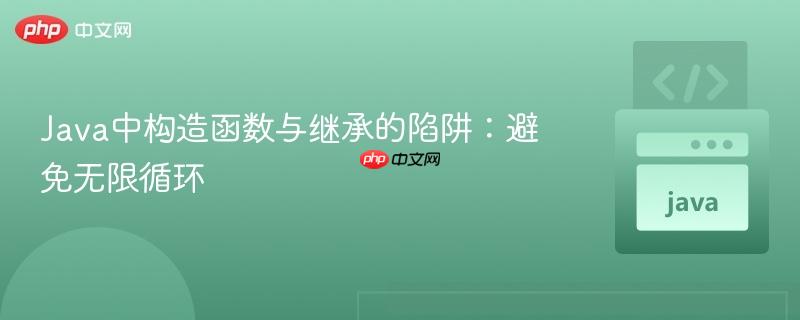
在java面向对象编程中,不当的构造函数设计,尤其是在继承体系中包含用户交互或复杂逻辑时,极易引发意料之外的递归调用,导致程序陷入无限循环。本文将深入剖析这种“无循环却循环”的现象,揭示其根源在于子类构造器隐式或显式调用父类构造器时,父类构造器中包含的逻辑被重复执行。我们将提供清晰的解决方案,指导开发者如何重构代码,将复杂的业务逻辑和用户输入从构造函数中分离,从而确保程序行为的正确性和可维护性。
许多开发者在初次接触Java继承时,可能会遇到一个令人困惑的问题:尽管代码中没有显式的 for 或 while 循环,但程序却反复执行某些代码块,尤其是在对象创建阶段。这种现象通常发生在子类构造函数调用父类构造函数(super())时,如果父类构造函数内部包含了用户输入或创建新对象的逻辑,就可能导致意料之外的递归调用。
考虑以下简化后的代码结构:
class Person {
public Person(String agentId, String password, String address) {
// ... 其他初始化代码 ...
Scanner input = new Scanner(System.in);
System.out.println("[1]AGENT");
System.out.println("[2]CUSTOMER");
int choice = input.nextInt(); // 这里会等待用户输入
if (choice == 1) {
// 如果选择1,这里可能会创建Agent对象
Agent agent = new Agent("Niel", "diko alam", "umay");
} else if (choice == 2) {
System.out.println("POTANGINA");
}
// input.close(); // 重要的资源管理,但此处不是核心问题
}
}
class Agent extends Person {
public Agent(String agentId, String password, String address) {
super(agentId, password, address); // 显式或隐式调用父类Person的构造函数
// ... Agent特有的初始化代码 ...
}
}
public class Finals {
public static void main(String[] args) {
// 尝试创建一个Person对象,然后创建一个Agent对象
Person person = new Person("20860132", "h208f32", "San luis");
Agent agent = new Agent("20860132", "h208f32", "San luis"); // 问题由此开始
}
}在上述代码中,当 main 方法执行 new Agent(...) 时,会发生以下步骤:
这就是所谓的“构造函数递归陷阱”,它不是由传统的循环语句引起的,而是由不当的构造函数设计和继承机制共同作用的结果。
立即学习“Java免费学习笔记(深入)”;
解决此问题的核心原则是:构造函数应专注于初始化对象的状态,而非执行复杂的业务逻辑或用户交互。 用户输入和对象类型选择的逻辑应该放在构造函数之外,例如在 main 方法或专门的工厂方法中。
以下是重构后的代码示例:
将用户输入和对象创建选择逻辑从 Person 构造函数中移除。Person 构造函数现在只负责初始化 Person 对象的属性。
import java.io.FileWriter;
import java.io.IOException;
import java.io.PrintWriter;
import java.util.Scanner;
import java.util.ArrayList;
import java.util.List;
class Person {
protected String agentId;
protected String password;
protected String address;
// 构造函数只负责初始化属性
public Person(String agentId, String password, String address) {
this.agentId = agentId;
this.password = password;
this.address = address;
// 移除用户输入和对象创建逻辑
}
// ... 其他方法(如果需要)
}Agent 类的构造函数现在可以专注于 Agent 对象的初始化,并调用 super() 来初始化 Person 部分的属性。
class Agent extends Person {
public Agent(String agentId, String password, String address) {
super(agentId, password, address); // 调用父类构造函数初始化Person属性
// 代理特有的登录和操作逻辑可以放在这里,或者更推荐放在Agent对象创建后调用的方法中
// 为了演示,我们将登录逻辑保留在构造函数中,但实际应用中应考虑进一步分离
Scanner input2 = new Scanner(System.in);
System.out.println("[LOGIN]");
System.out.print("ENTER AGENT ID:");
// 建议使用 nextLine() 读取整行,然后解析为 int,以避免 Scanner 缓冲区问题
String idStr = input2.nextLine();
int id = Integer.parseInt(idStr);
System.out.print("ENTER PASSWORD:");
String passStr = input2.nextLine();
int pass = Integer.parseInt(passStr);
if (id == 20860132 && pass == 20020729) {
System.out.println("AGENT LOGIN SUCCESSFUL.");
// 登录成功后的操作菜单可以放在一个单独的方法中,例如 operateAgentMenu()
// Scanner input = new Scanner(System.in); // 不应在构造函数内频繁创建Scanner
// ... 菜单逻辑 ...
} else {
System.out.println("INCORRECT PLEASE TRY AGAIN.");
}
// input2.close(); // 重要的资源管理,但需注意在整个应用生命周期中Scanner的创建和关闭策略
}
// ... addCar, schedule, records 等方法 ...
public void addCar(List<String> cars) {
try (FileWriter fw = new FileWriter("cars.txt", true);
PrintWriter pw = new PrintWriter(fw)) { // 使用 try-with-resources 自动关闭资源
pw.println(cars);
} catch (IOException e) {
e.printStackTrace();
}
}
// 其他方法类似修改为 try-with-resources
}与 Agent 类似,Customer 构造函数也应只专注于初始化。
class Customer extends Person {
private String customerId;
public Customer(String agentId, String password, String address, String customerId) {
super(agentId, password, address);
this.customerId = customerId;
}
// ... 其他方法 ...
}现在,main 方法将负责处理用户选择是创建 Agent 还是 Customer,并根据选择调用相应的构造函数。
public class Finals {
public static void main(String[] args) {
Scanner mainInput = new Scanner(System.in); // 在main方法中创建一次Scanner
System.out.println("Welcome to the System!");
System.out.println("[1] AGENT");
System.out.println("[2] CUSTOMER");
System.out.print("Please choose your role: ");
int choice = -1;
try {
choice = mainInput.nextInt();
mainInput.nextLine(); // 消费掉换行符,避免影响后续 nextLine() 调用
} catch (java.util.InputMismatchException e) {
System.out.println("Invalid input. Please enter a number.");
mainInput.nextLine(); // 清除无效输入
// 可以选择重新提示用户输入或退出
return;
}
Person user = null; // 定义一个Person引用来存储创建的对象
if (choice == 1) {
// 创建 Agent 对象
Agent agent = new Agent("20860132", "h208f32", "San luis");
user = agent; // 将agent对象赋给user引用
// 登录成功后,可以调用 Agent 对象的菜单方法
// agent.showAgentMenu(mainInput); // 假设Agent有一个显示菜单的方法
} else if (choice == 2) {
// 创建 Customer 对象
Customer customer = new Customer("defaultAgentId", "defaultPass", "defaultAddress", "CUST001");
user = customer; // 将customer对象赋给user引用
System.out.println("CUSTOMER role selected.");
// 登录成功后,可以调用 Customer 对象的菜单方法
// customer.showCustomerMenu(mainInput); // 假设Customer有一个显示菜单的方法
} else {
System.out.println("Invalid choice. Exiting.");
}
// 可以在这里根据user的类型执行后续操作
if (user != null) {
System.out.println("User created: " + user.getClass().getSimpleName());
// 例如,如果user是Agent,可以调用其特有方法
// if (user instanceof Agent) {
// ((Agent) user).someAgentSpecificMethod();
// }
}
mainInput.close(); // 在程序结束时关闭Scanner
}
}通过遵循这些原则和建议,开发者可以有效避免因构造函数设计不当导致的无限循环问题,并构建出更加健壮、可维护的Java应用程序。
以上就是Java中构造函数与继承的陷阱:避免无限循环的详细内容,更多请关注php中文网其它相关文章!

每个人都需要一台速度更快、更稳定的 PC。随着时间的推移,垃圾文件、旧注册表数据和不必要的后台进程会占用资源并降低性能。幸运的是,许多工具可以让 Windows 保持平稳运行。

Copyright 2014-2025 https://www.php.cn/ All Rights Reserved | php.cn | 湘ICP备2023035733号